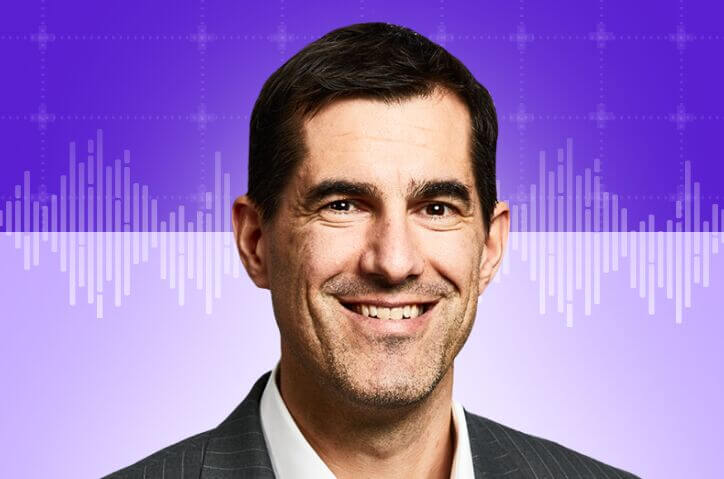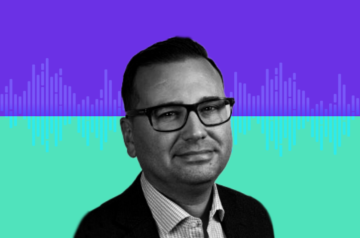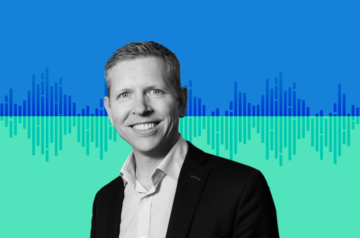
[embedded content]
In this episode of the IoT For All Podcast, Marc Sauter, Head of IoT Product Management at Vodafone, joins Ryan Chacon to discuss what businesses should consider when buying IoT connectivity. Marc highlights Vodafone’s global efforts to connect businesses intelligently, offering real-time operational data that can help automate processes. He outlines the role of artificial intelligence in IoT and predicts an increased adoption of IoT in healthcare and manufacturing due to demographic challenges. Marc also shares some common challenges in IoT such as reliability and security.
About Marc Sauter
Marc Sauter is responsible for leading Vodafone’s IoT Product Management including flagship products like IoT Management Platform GDSP, Invent and Internet in the Car (IITC). Marc has a wealth of senior management experience. After starting his career at HP, he went on to work at Siemens and Cinterion Wireless Modules, focusing on R&D, strategy, business development, and product management within the communications and industry sector. Marc holds a Master’s degree in Electrical Engineering from the University of Cambridge in the UK and a Master’s in Business Administration from the European School of Business in Reutlingen, Germany.
Interested in connecting with Marc? Reach out on LinkedIn!
About Vodafone
Vodafone is the largest pan-European and African telecoms company. Their purpose is to connect for a better future by using technology to improve lives, digitalize critical sectors, and enable inclusive and sustainable digital societies. They provide mobile and fixed services to over 300 million customers in 17 countries, partner with mobile networks in 46 more, and are also a world leader in the Internet of Things (IoT), connecting over 167 million devices and platforms.
Key Questions and Topics from this Episode:
(00:13) Introduction to Marc Sauter and Vodafone
(01:36) What does Vodafone do?
(03:06) Buying IoT connectivity: what to consider
(10:20) Future-proofing IoT connectivity
(12:56) Advice for companies starting to connect devices
(16:10) Common challenges in IoT adoption
(17:53) Predictions for IoT in 2024
(19:20) What industries will start adopting IoT more?
(20:29) The intersection of IoT and AI
(21:56) Learn more and follow up
Transcript:
– [Ryan] Welcome Marc to the IoT For All Podcast. Thanks for being here this week.
– [Marc] Yeah, thank you, Ryan. It’s a pleasure.
– [Ryan] Yeah, I’m very excited to have you. Before we jump into the conversation that we have planned, would you mind giving, introducing yourself a bit to our audience and giving an overview of Vodafone and what you all are doing in the IoT space?
– [Marc] Yeah, sure. Look, I’ve been with Vodafone for 14 years, always in IoT, and had various roles from leading strategy and business development, marketing and strategy. I’m currently, I’m responsible for portfolio and product management. So working on pretty exciting stuff and creating the future for Vodafone IoT.
Basically, working on which new products and features we’re going to develop to help our customers transforming their business and succeeding in an increasingly competitive place. Prior to Vodafone, I used to work at Siemens, HP, and a smaller machinery company in Canada, always with some IoT context.
Although 25 years ago, it wasn’t called IoT but industry automation or machine to machine, M2M. So overall, I’m really passionate about IoT because of the potential it has to transform our business and lives and the positive impact on society. For me, it’s super rewarding to be part of an industry that helps patients to get out of hospital sooner or helps enterprises to reduce their CO2 emissions.
– [Ryan] I think the industry has come a long way probably over those 25 years, and it’s definitely in a very exciting place. So let me ask about Vodafone specifically. What role do you all play in the IoT space? And this is a kind of a question for those who may not be as familiar with what you all do and what you’re providing to the industry and where you’re slotting yourself in.
– [Marc] We at Vodafone, we have been helping organizations of all sizes to intelligently and reliably connect your business globally with our leading IoT connectivity solution for over 30 years, and we help them to intelligently connect machines, asset, things, and people, and businesses have access to operational data almost in real time and can use this to automate processes, reduce operating costs, and gain flexibility.
So basically, they can turn data into meaningful information to make informed decisions and run their operations better. In addition, it helps them to develop new business models and revenue streams to stay competitive. Today, we support over 160 million IoT connections across a range of industries from utilities, manufacturing, logistics, automotive, agriculture, healthcare.
And I think all of this is becoming even more important in light of AI. You could even say that IoT connectivity is an enabler for AI, for artificial intelligence, as IoT helps to make the data from all these machines, assets, et cetera, available to get processed and analyzed by AI.
– [Ryan] Absolutely. No, that’s a great point. So, I guess you’d be a great person to ask this next question to then. If I’m a business out there looking to looking at how best to select the IoT connectivity for my devices to connect, what should businesses really consider? What should I as a business owner or I as a company looking to adopt an IoT solution be really thinking about and considering when it comes to the purchasing and selecting of IoT connectivity that matches or that fits best with the solution that is being built or deployed?
– [Marc] Very good question because IoT connectivity is often mission critical. So from that perspective, it’s really important that you clearly specify your use case and the requirements in terms of IoT connectivity from the start.
For example, you know, what services are needed, what data usage is needed, where will the devices be deployed, et cetera. And we can dive into all these different parameters if you want.
– [Ryan] Yeah, feel free to expand on a few of those. I think it’s good. We’ve talked in the past about the, those different points from have, different experts have talked about them, but it’d be good to maybe bring it all together and talk about why it’s so important that you understand your use case to be able to understand the requirements and the parameters that, what kind of data is coming in, how fast you need the data, how much data it is. All these different things are going to dictate the type of connectivity that is a match for your solution and not and also not be overkill and also not underperform when in the environment that the hardware and the solution is being deployed in.
– [Marc] Yeah, absolutely. And then look it all hangs together because all this has an impact on the overall solution and therefore the total cost of ownership because you need to start from the device.
Another type of connectivity you select will have an impact on the device. And also then on the cost and all that kind of stuff. I know the first question I would ask is which services does your use case need? Is it data only? For example, if you have a production machine where you regularly need to do a software upgrade and data is perfectly fine. Or do you also need voice and SMS capabilities like in lifts and elevators to support an emergency call? I was once stuck in an elevator, and I was happy to press the button and talk to somebody and say, hey, I got stuck. Can you please help me? For those use cases, then you also need voice.
Then, assuming you’re okay with data only, then the question is what is the expected throughput or data usage? In our case, with our customers, we have customers and use cases with a monthly data usage of more than one gigabyte. And for example, that’s updating the software of a production machine or remotely managing assets like a wind turbine or updating the map of your navigation system in the car. So these then require a solid 4G at least, or even better, a 5G connection.
On the other extreme, we have use cases that only require a few kilobyte of data per year. So for example, a smoke detector, right? In this case, LTE-M or Narrowband IoT are the best choice and that has a direct impact on the cost of the module of the device because an LTE-M or Narrowband IoT device or module is much cheaper than a 4G or 5G module. And then, of course, there are all these other use cases that are in between, like electricity, gas, water meters, farming, medical devices, and so on.
Okay, so when you have clarity on the throughput and the data usage of your device, then the next question I would ask is where the devices will be deployed. So this starts with deployments in one country versus international deployments. So, you need a solution that supports roaming abroad in this case or other devices deployed in hard to reach locations such as basements.
You know, for example, my dad just recently installed a solution to remotely monitor the oil tank in his old house. So obviously the tank is in the basement and coverage is really poor because of the physics. But then the solution here is Narrowband IoT or LTE-M again, which are designed for better deep indoor coverage.
And then also in these cases, think about the energy consumption of the device and access. In some cases, there is no external power supply, and your device depends on the battery. For example, if you think about a smoke detector or a sensor to measure water levels of a river to send an alarm in case of flooding. So, you want these devices to operate as long as possible with the smallest battery, so again, the solution is LTE-M or Narrowband IoT.
Then the fourth question is how often does the device need to transmit information? And what’s the impact if you don’t have a reliable service? How mission critical is it? And here we are talking about the reliability and resilience. In our solutions, for example, we provide a feature that is called national roaming, which gives you access to more than one network, more than one radio network in any country. And that significantly increases your chances to get a signal and have good coverage. And the other aspect is latency. So here, obviously, 5G and specifically 5G standalone provide the lowest latency, which is almost real time. And this is required to remotely operate a crane or a remote surgery.
And then last but not least, the question is how do you want to manage your use cases and devices? So most of our customers, they require sophisticated capabilities to manage their SIMs and connections. For example, if you manufacture your devices in Asia, and you want to have a final test of the solution at the end of production, then the device gets shipped to Europe, and only a few weeks later, then the device and the solution is sold and used. And in this case, our customers can use our management platform to put the SIM into a test mode for the final production test, then into a sleep mode during shipping, and then activate them just before usage. They also can manage data usage to see where and how the devices are used, etc. And that’s all remotely done through our platform.
Most customers use our APIs to connect our platform to their systems. But we also have an online portal, which is used as well. So these are the five points I think. You need to get clarity and sort it out before you start in selecting the best connectivity for your use case.
– [Ryan] That’s fantastic. Yeah, it sounds like from a company perspective, a buyer perspective, it’s really important that they understand all the intricate details that they possibly can about their use case, the environment in which it’s going to be deployed, are their devices going to be moving from region, between regions. Is it gonna be staying in one area? As you mentioned, the types of data that’s going to be transmitted, how often they need the data, things like that.
What about thinking about after the deployment, I guess it probably could be thought about more after the deployment is done, there’s going to be new technologies that come out in the future, there’s going to be sunsetting of networks in the future. Are there things that companies can do or think about to help prepare themselves for future technologies down the line or other types of technologies that may exist that will influence their decision on the types of connectivity that they choose for their solution?
– [Marc] Yeah, absolutely. Firstly, IoT is enabling many innovations across all industries, but then there is also a lot of innovation happening within IoT. So Vodafone, for example, is working with industry bodies on the definition and standardization of future technologies and often leading these activities.
I am particularly excited about 5G and the additional opportunities and innovation it brings. Today, we already connect several million devices with 5G. These devices benefit from the increased throughput and bandwidth of 5G, but even more advancements will come with 5G standalone, standalone with a real 5G core network. In addition to the increased speed, this will also provide super low latency and higher quality of service through network slicing, and this will enable a whole raft of new use cases, specifically mission critical and real time use cases like autonomous driving, remote surgery, smart energy grids, and many more.
– [Ryan] Do you think this is something that as an adopter of these technologies is important for companies to monitor and track and understand themselves? Or is this something that an organization like Vodafone and the companies that they work with to bring a solution to life are going to help guide them through as the future kind of unfolds?
– [Marc] Yeah, I think both. Look, most of our customers, their core competency is not around communications or connectivity, right? Their competency is manufacturing and developing cars or medical devices or other things. Therefore, it’s good to have a strong partner that helps them on what’s happening in the telco space and really provides good consulting services and guides them on what’s happening here. But obviously, it’s also, it doesn’t harm if they also watch and monitor what’s going on in the industry here as well.
– [Ryan] So let’s take it one step further, and the company has made a decision on the type of connectivity that they’re going to use, and now they’re starting to connect their devices. What advice do you have for companies that are just getting started connecting their devices to the network and really starting to deploy their IoT solution?
– [Marc] So just basically what we talked about before, clearly define your requirements, what use cases, services, et cetera, but then also work with a strong partner who has the experience in this area, strong reference cases, and who can help and consult you to refine these requirements, maybe even challenging you and providing a different perspective that might lead to a better overall solution. Now, this partner should also make it easy for you to deploy and manage IoT. If you have international operations, your partner should also have global expertise and set up and industry experience to support you. And then the solution you select should be secure, reliable, scalable, and intelligent to provide good quality connectivity services to you and your business which you can rely on.
And overall, the advice I always have and give to customers who actually have not had any IoT project yet is to start with a smaller pilot or proof of concept, connect some devices, test it, get some experience, validate your assumptions, and potentially refine your requirements. And then based on this pilot and the experience you got, customers can then march on to larger deployments with confidence.
From our experience, most customers that start small quickly realize the additional value they can get by connecting the devices. And then for this journey and process, you need a strong partner that walks with you and provides the support and expertise you need.
– [Ryan] How does that advice differ for the companies that are in the IoT space? So let’s say device builders, solution builders, as opposed to the adopters of the end solution. Is there a kind of different advice or any of that advice tweaked in any way that makes those types of organization that you either work with or connected with in some capacity unique in how they’re approaching it versus just the higher level user or company that is going to just adopt a solution for their particular problem and try to solve it?
– [Marc] Yeah, each customer is a little bit different. So therefore, really important that you select a partner that has broad experience and expertise, right? Like in Vodafone, for example, we have thousands of customers across all sizes, across all verticals, also worldwide. So, we have over the last 25, 30 years accumulated a lot of experience and expertise, which then our customers can benefit from. I think this is really the benefit and the differentiator here, and each IoT project is also slightly different with different requirements. So, you always often need to customize it and be very specific and bespoke.
– [Ryan] Are there any common challenges that you come across working with these companies or that you realize a lot of these companies have in their adoption of IoT solutions? Is there anything that you witnessed from your perspective that might be worth sharing with our audience of things just to keep in mind outside of the obviously the decision making process for choosing the IoT connectivity, but just generally as a whole, are there common challenges like, let’s say, solutions that have devices that are traveling through lots of different regions, which you’ve talked about roaming, but what about like hard to reach locations? What about when you’re starting to talk about assets that are moving a lot more like vehicles, talking about bringing voice into it, things like that. Are there other challenges that are starting to appear these days more than maybe in the past that are worth sharing kind of thoughts on how to, or what considerations you should have and how to overcome them?
– [Marc] Our world gets more connected every day. There are so many sensors, actors, devices, assets out there that benefit from being connected, and more and more of these things get actually connected. So therefore, the businesses but also we as a society and individuals depend much more on this connected world and having a stable and reliable connectivity. So from that perspective, I think having this reliability is super important. Resilience is super important. And then also the security is super important because you want to make sure that your data is not compromised. These are challenges that go across basically all industries, all customers, that reliability, resilience, security is increasingly important.
– [Ryan] I guess the, one of the last questions I have is as we’re now in 2024, what do you predict or see or expect or most excited about happening in 2024? In from a Vodafone perspective, from just an industry perspective in the work that you do, the companies that you work with, where do you, where should people be keeping an eye on and what do you foresee coming about that will really take this to the next level?
– [Marc] Yeah, look, I’m super excited about the future of IoT, specifically in light of artificial intelligence because I think the opportunities, it’s just massive that’s out there. And the more devices, assets, things we connect, the better it will be, the more data we have for to feed the artificial intelligence machines and that can only drive a lot of benefits, right?
I’m, as I said earlier, I’m super excited to develop with our customers innovative solutions that really transform businesses and lives. And as I said, it’s super rewarding to see patients coming out of hospital sooner or to further reduce CO2 emissions. These are the things that really keep me going and also keep the Vodafone team going. We are highly committed on innovating and providing the best solutions to our customers and really helping them to succeed in their space.
– [Ryan] Are there any industries that you feel are going to take the next step in IoT adoption? Because obviously there’s been many different use cases and industries that are, that have been leading the way for many years. Do you see any kind of that you suspect will start to really adopt IoT more that maybe hasn’t been one of the larger adopters in the past maybe because of the maturity of certain technologies and things like that. Is there any kind of industry that you’re really focused on keeping an eye on?
– [Marc] Yeah, I think the demographic challenges that we have in specifically in the more developed world where we are struggling to get highly qualified people that will drive even more adoption of AI and IoT and those kind of things. Automation in areas like healthcare but also in areas like manufacturing, right, because then you can automate more things and this is where I’m super excited, and I think the adoption of IoT and connectivity in those areas will actually significantly increase over the coming 24, 36 months.
– [Ryan] And what about AI? You’ve mentioned that a few times. We’ve been focused a lot on AI the last probably year or so because of how close knit IoT and AI are. With the work that you all do, how does AI fit into the spectrum of offerings and the stuff that you engage with customers around?
– [Marc] Well, there are two things to it, right? So first of all, we in our products and solutions, we will increasingly adopt AI and machine learning and those kind of things to make our service better and even more reliable and resilient and more secure. So that’s one aspect. But then also by connecting more devices, more assets, more data will be provided to these AI machines, and they can then process more data and more in real time, and that can only help to drive the outcome of AI processes.
– [Ryan] Yeah, it’s avery exciting time. I think 2024 is going to be a really great year across the board. I think we’re seeing more companies understand the value of IoT, understand what it can do for their business, how other companies in their industry are utilizing it to solve certain problems. And I think technologies have come a long way to really make it something that they can see a quicker ROI and really justify getting to scale, which is where everyone here wins if companies are able to see that and get to that more quickly. So, I really appreciate you taking the time to share your insights today, and I guess the last thing I have for you is just to let our audience know where they can learn more about what you all have going on, potentially follow up with any questions, anything like that.
– [Marc] Yeah, first of all, Ryan, thank you very much for giving me the opportunity. Then, yeah, if interested companies want to get in touch with us, then I think the first place is our web page. But then also, we have in most countries, we have a Vodafone representative, IoT sales force, also in the US or in Japan, then just get in touch with them, and we will help you and work with you to make your business connected.
– [Ryan] Mark, thank you so much. This has been great. We’ve always loved the opportunities to work with Vodafone on content and kind of talk about your all’s expertise, what you have going on in the industry. We think what you’re doing is great. Really appreciate the time, and hopefully we’ll have the opportunity to talk again in the future.
– [Marc] Thank you very much, Ryan.
- SEO Powered Content & PR Distribution. Get Amplified Today.
- PlatoData.Network Vertical Generative Ai. Empower Yourself. Access Here.
- PlatoAiStream. Web3 Intelligence. Knowledge Amplified. Access Here.
- PlatoESG. Carbon, CleanTech, Energy, Environment, Solar, Waste Management. Access Here.
- PlatoHealth. Biotech and Clinical Trials Intelligence. Access Here.
- Source: https://www.iotforall.com/podcasts/e328-what-to-consider-when-buying-iot-connectivity
- :has
- :is
- :not
- :where
- $UP
- 01
- 06
- 10
- 12
- 13
- 14
- 16
- 160
- 167
- 17
- 19
- 20
- 2024
- 24
- 25
- 29
- 30
- 300
- 36
- 46
- 5G
- a
- Able
- About
- abroad
- absolutely
- access
- Accumulated
- across
- activate
- activities
- actors
- actually
- addition
- Additional
- administration
- adopt
- adopters
- Adopting
- Adoption
- advancements
- advice
- African
- After
- again
- ago
- agriculture
- AI
- alarm
- All
- almost
- already
- also
- always
- am
- an
- analyzed
- and
- any
- anything
- APIs
- appear
- appreciate
- approaching
- ARE
- AREA
- areas
- around
- artificial
- artificial intelligence
- AS
- asia
- ask
- aspect
- asset
- Assets
- assumptions
- At
- audience
- automate
- Automation
- automotive
- autonomous
- available
- Bandwidth
- based
- Basically
- battery
- BE
- because
- becoming
- been
- before
- being
- benefit
- benefits
- bespoke
- BEST
- Better
- between
- Bit
- board
- bodies
- both
- bring
- Bringing
- Brings
- broad
- builders
- built
- business
- business development
- business models
- business owner
- businesses
- but
- button
- BUYER..
- Buying
- by
- call
- called
- cambridge
- CAN
- Can Get
- Canada
- capabilities
- Capacity
- car
- Career
- cars
- case
- cases
- certain
- cetera
- challenges
- challenging
- chances
- cheaper
- choice
- Choose
- choosing
- clarity
- clearly
- Close
- co2
- co2 emissions
- come
- comes
- coming
- committed
- Common
- Communications
- Companies
- company
- competitive
- Compromised
- concept
- confidence
- Connect
- connected
- Connecting
- connection
- Connections
- Connectivity
- Consider
- considerations
- considering
- consulting
- consumption
- content
- context
- Conversation
- Core
- Cost
- Costs
- could
- countries
- country
- course
- coverage
- Creating
- critical
- Currently
- customer
- Customers
- customize
- Dad
- data
- day
- Days
- decision
- Decision Making
- decisions
- deep
- define
- definitely
- definition
- Degree
- demographic
- depend
- depends
- deploy
- deployed
- deployment
- deployments
- designed
- details
- develop
- developed
- developing
- Development
- device
- Devices
- dictate
- differ
- different
- differentiator
- digital
- direct
- discuss
- dive
- do
- does
- Doesn’t
- doing
- done
- Dont
- down
- drive
- driving
- due
- during
- E&T
- each
- Earlier
- easy
- either
- electrical engineering
- electricity
- embedded
- emergency
- Emissions
- enable
- enabler
- enabling
- end
- energy
- Energy Consumption
- engage
- Engineering
- enterprises
- Environment
- episode
- etc
- Europe
- European
- Even
- Every
- every day
- everyone
- example
- excited
- exciting
- exist
- Expand
- expect
- expected
- experience
- expertise
- experts
- external
- extreme
- eye
- familiar
- fantastic
- farming
- FAST
- Feature
- Features
- feel
- few
- final
- fine
- First
- firstly
- fit
- fits
- five
- fixed
- flagship
- Flexibility
- focused
- focusing
- follow
- For
- Force
- foresee
- Fourth
- Free
- from
- further
- future
- Gain
- GAS
- generally
- Germany
- get
- getting
- Give
- gives
- Giving
- Global
- Globally
- Go
- going
- good
- got
- great
- guide
- Guides
- had
- hangs
- Happening
- happy
- Hard
- Hardware
- harm
- Have
- having
- he
- head
- healthcare
- help
- helping
- helps
- here
- higher
- highlights
- highly
- his
- holds
- Hopefully
- Hospital
- House
- How
- How To
- HP
- HTTPS
- i
- if
- Impact
- important
- improve
- in
- Including
- Inclusive
- Increase
- increased
- Increases
- increasingly
- individuals
- Indoor
- industries
- industry
- influence
- information
- informed
- innovating
- Innovation
- innovations
- innovative
- insights
- installed
- Intelligence
- Intelligent
- interested
- International
- Internet
- internet of things
- intersection
- into
- intricate
- introducing
- iot
- IoT Device
- IT
- Japan
- Joins
- journey
- jpg
- jump
- just
- Keep
- keeping
- Kind
- knit
- Know
- larger
- largest
- Last
- Latency
- later
- lead
- leader
- leading
- LEARN
- learning
- least
- let
- Level
- levels
- Life
- light
- like
- Line
- little
- Lives
- locations
- logistics
- Long
- Look
- looking
- Lot
- lots
- loved
- Low
- lowest
- machine
- machine learning
- machinery
- Machines
- made
- make
- MAKES
- Making
- manage
- management
- managing
- manufacturing
- many
- map
- March
- mark
- Marketing
- massive
- master’s
- Match
- matches
- maturity
- May..
- maybe
- me
- meaningful
- measure
- medical
- medical devices
- mentioned
- might
- million
- mind
- Mission
- Mobile
- mobile networks
- Mode
- models
- module
- Modules
- Monitor
- monthly
- monthly data
- months
- more
- most
- moving
- much
- my
- National
- Navigation
- Need
- needed
- network
- networks
- New
- new products
- New technologies
- next
- no
- now
- of
- offering
- Offerings
- often
- Oil
- Okay
- Old
- on
- once
- ONE
- online
- only
- operate
- operating
- operational
- Operations
- opportunities
- Opportunity
- opposed
- or
- organization
- organizations
- Other
- our
- out
- Outcome
- outlines
- outside
- over
- overall
- Overcome
- overview
- owner
- ownership
- page
- parameters
- part
- particular
- particularly
- partner
- passionate
- past
- patients
- People
- per
- perfectly
- person
- perspective
- Physics
- pilot
- Place
- planned
- platform
- Platforms
- plato
- Plato Data Intelligence
- PlatoData
- Play
- please
- pleasure
- podcast
- Point
- points
- poor
- Portal
- portfolio
- positive
- possible
- possibly
- potential
- potentially
- power
- Power Supply
- predict
- Predicts
- Prepare
- press
- pretty
- Prior
- probably
- Problem
- problems
- process
- processed
- processes
- Product
- product management
- Production
- Products
- project
- proof
- proof of concept
- provide
- provided
- provides
- providing
- purchasing
- purpose
- put
- qualified
- quality
- question
- Questions
- quicker
- quickly
- R&D
- Radio
- range
- reach
- real
- real-time
- realize
- really
- recently
- reduce
- reference
- refine
- region
- regions
- regularly
- reliability
- reliable
- rely
- remote
- remotely
- representative
- require
- required
- Requirements
- resilience
- resilient
- responsible
- revenue
- rewarding
- right
- River
- ROI
- Role
- roles
- Run
- Ryan
- s
- Said
- sales
- Sauter
- say
- scalable
- Scale
- School
- sector
- Sectors
- secure
- security
- see
- seeing
- select
- selecting
- send
- senior
- sensors
- service
- Services
- set
- several
- Share
- Shares
- sharing
- shipped
- Shipping
- should
- Siemens
- Signal
- significantly
- SIM
- sims
- sizes
- sleep
- slightly different
- small
- smaller
- smallest
- smart
- Smoke
- SMS
- So
- Society
- Software
- sold
- solid
- solution
- Solutions
- SOLVE
- some
- something
- sophisticated
- sounds
- Space
- specific
- specifically
- Spectrum
- speed
- stable
- standalone
- standardization
- start
- started
- Starting
- starts
- stay
- staying
- Step
- Strategy
- streams
- strong
- Struggling
- succeed
- such
- Super
- supply
- support
- Supports
- sure
- Surgery
- sustainable
- system
- Systems
- Take
- taking
- Talk
- talking
- tank
- team
- Technologies
- Technology
- Telco
- telecoms
- terms
- test
- than
- thank
- thanks
- that
- The
- The Future
- the security
- the UK
- their
- Them
- themselves
- then
- There.
- therefore
- These
- they
- thing
- things
- Think
- Thinking
- this
- this week
- those
- thought
- thousands
- Through
- throughput
- time
- times
- to
- today
- together
- Topics
- Total
- touch
- track
- Transform
- transforming
- transmit
- Traveling
- try
- turbine
- TURN
- two
- type
- types
- Uk
- understand
- unique
- university
- university of cambridge
- updating
- upgrade
- us
- Usage
- use
- use case
- used
- User
- using
- utilities
- Utilizing
- VALIDATE
- value
- various
- Vehicles
- Versus
- verticals
- very
- vodafone
- Voice
- walks
- want
- was
- Watch
- Water
- Way..
- we
- Wealth
- web
- week
- Weeks
- welcome
- WELL
- went
- What
- What is
- when
- which
- WHO
- whole
- why
- will
- wind
- wind turbine
- Wins
- wireless
- with
- within
- witnessed
- Work
- working
- world
- worldwide
- worth
- would
- year
- years
- yet
- you
- Your
- yourself
- youtube
- zephyrnet








